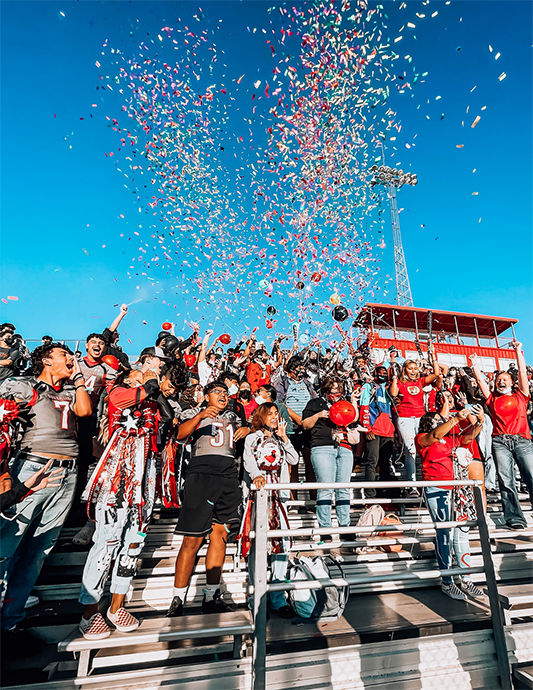Keeping In Touch
How to Maintain and Reenergize Your District Advocates

This article is even better when paired with the companion discussion guide.
It always bears repeating: To be a thriving school system, you need a strategy for developing strong, passionate advocates. After all, what you say about your schools matters much less than what others say about them. In past issues, we’ve compared growing advocates to farming: planting the seeds of personal, intentional moments that inspire your staff, students, and community members to tell your schools’ best stories.
But what happens when your advocates lose their immediate connection to your district? When families no longer have school-aged children? When a devoted teacher retires or a student graduates? Are they still adding to a positive narrative surrounding your schools? And don’t forget the countless members of your community who have no direct ties to your district. How do you plant those seeds of advocacy when your audience may not even know they should be listening?
With support for public education at a cultural and political flashpoint, it may be time to consider not only how you’re growing advocates for your district, but also how you’ll maintain them. It’s crucial, now more than ever, to keep all of your advocates engaged, informed, and supportive—no matter their relationship to your schools.
Perhaps this calls for a new metaphor altogether. Let’s talk about quilts—multilayered patchworks bringing together arrays of colors, textures, and designs. Each piece of a quilt’s fabric has its own unique shape and character, all combining to make one interconnected piece of art. But weaving those composite pieces together also takes time, dedication, and attention to detail.
Can you see where we’re going with this? Your district’s story is the quilt, and its fabric is made of the students, families, and community members you serve. Each of your advocates is a distinct patch on that quilt, and the threads that tie them together must be intentional, thoughtful, and—more than anything—long-lasting.
Thread the needle.
The most important aspect of advocacy is the foundation you build with your school community. Your first and most important goal should be to consistently and systematically develop advocates who will sing your district’s praises. This is the backbone of advocacy marketing—collecting a coalition of storytellers to share your best work. By putting in effort on the front end to nurture and grow your advocates, you’re investing in long-term dividends. Your advocates will remain an engaged, active part of your district.
Remember, advocates don’t come from a barrage of billboards, ads, and flyers. Advocates are born in singular moments that make people feel seen, understood, and cared for—moments that make for stories worth telling. Here’s a quick recap of our tried-and-true methods for cultivating the kind of advocates that last a lifetime:
It’s not enough to create a strong foundation of advocates—you also have to maintain them. Let’s look at a few districts who are keeping their communities of advocates tightknit and ensuring that no matter where they are, the people who love their schools stay connected, informed, and enthusiastic.
Foster mutually beneficial partnerships.
Dr. Benjamin Churchill is currently serving his seventh year as superintendent of California’s Carlsbad Unified School District (CUSD). When we asked him how he grows and maintains advocates for Carlsbad’s schools, he brought up the district’s history of strong partnerships. “We are intentional about finding ways to maintain engagement with those who have historically been very supportive of our schools,” he explains. “We think carefully about how to engage with parents, community members, and business folks.”
One of the district’s most successful partnerships is with their education foundation, which raises about $1 million annually for Carlsbad schools. “We are fortunate to live in a community where people support our schools, but that doesn’t happen by accident,” Churchill says. “We do it through a lot of outreach, by finding concrete ways for our partners to see the fruits of their labors and the impact of their financial donations.”
Carlsbad finds unique opportunities to stitch partners into the fabric of the district while also meeting the needs of another group of advocates—parents. “We have a parent-superintendent advisory council made up of the PTA presidents from every school site,” he tells us. “We also invite representatives from our education foundation to attend those monthly meetings.” Moreover, these meetings are held at a different school every month. “I prioritize holding them in the schools that have been most recently modernized or schools that have programs directly impacted by foundation support. I get to meet with parents and community members, and they get to visit our schools and see our programs,” Churchill says.
CUSD also has a strong relationship with the Carlsbad Chamber of Commerce, and that partnership continues to impact countless students every day. “Our chamber is one of the largest in Southern California,” Churchill tells us. “We collaborate with them on a couple of projects that connect our students to business people they wouldn’t ordinarily network with.” One such initiative is the Rising Star of the Month Program, in which each of the district’s high schools nominates a “rising star” student to attend a monthly breakfast with local business leaders. In addition to giving presentations to attendees, these business leaders get to learn about students’ interests, plans for the future, and what resources they need to be successful.
“Once these business leaders make those connections with the students, they absolutely become advocates for our schools,” Churchill says. “Someone from an engineering firm might hear a kid talk about studying engineering and then help them find an internship or other opportunity.” These partnerships with local businesses don’t just grow new advocates; they also build sustainable, long-term relationships that benefit the students, schools, and local industry.
This includes more than job shadowing and internships. The district is always looking for new ways to involve businesses in the learning paths they offer their students. For example, Churchill and his team often invite business leaders to be part of the district’s Career Education Advisory Committee to discuss strengthening the career pathways in their middle and high schools. “We find ways, such as our committees and internships, to keep these advocates engaged in our schools,” says Churchill. “It’s a win-win.”
Illuminate your alumni.
“No one is more prideful than our alumni,” says Monica Saenz, webmaster and communications specialist at Southside ISD in Texas. Southside is known for what Saenz calls “feel-good community stories,” an identity they’ve built over time by prioritizing community involvement. A big part of that involvement is rooted in their strong cadre of alumni.
“We’re on the outskirts of San Antonio,” Saenz tells us. “There’s not much in this area, so we have to stick together.” And that means graduates, too. Southside involves their alumni by keeping them in the loop about district changes, updates, and progress through their newsletter, Cardinal Headlines.
But while keeping alumni updated is good, getting them to talk positively about your schools is even better. This often means offering support to your advocates. As the largest organization in their community, Southside ISD fills a lot of gaps for their community members. Because the district is rural, alumni often look to Southside for resources they may not otherwise have access to.
At their most recent Back-to-School Bash, the district not only gave away school supplies and uniforms to students, but also offered a free vaccine clinic for anyone in the community, including alumni. That may sound like a lot of work—and it is. But it also provides the district with a never-ending supply of positive stories that instill and sustain a strong sense of pride in their graduates. “Our alumni really are our biggest advocates,” Saenz says. “When someone tells you they’re from Southside, you know immediately how much pride they have in our schools and what they’ll do to support us.”
By maintaining relationships with your alumni, you’re also investing in future generations of students. If a former student is still connected to your schools in some way, they’re all the more likely to choose your district for their own children. “Our biggest goal is keeping the community involved,” Saenz says. “They’re the ones supporting us; they’re the ones sending their kids to our schools.”
Serve with empathy and kindness.
There are myriad ways to connect and stay connected to your district’s stakeholders. But the best and arguably easiest strategy is to serve them with empathy and kindness. The long-term advocacy earned through hospitality isn’t something to be overlooked. Leading with kindness and modeling it throughout your district makes for a stronger, more passionate network of advocates—ones who are proud and excited to help tell the story of your schools.
As you interact with your school community—whether students, families, or staff—your goal should be more than just delivering services. Providing those services with kindness and empathy meets a deeper need: the inherent human desire to feel important, cared for, and valued. It’s not just about meeting needs, but meeting them in a way that makes people feel like they matter to you. More often than not, that means going above and beyond what’s necessary in a given situation—making someone feel special not because you have to, but because you want to.
Now retired after more than 30 years in public education, former superintendent Kelly E. Middleton continues to promote the power of genuine relationships in schools, training other educators to think about hospitality and service. He once took a walk in a student’s footsteps—literally.
Just after taking the helm at Kentucky’s Newport Independent Schools, Middleton received a call from a grandmother asking if a school bus could pick up her granddaughter, Lisa. Because she lived near the school, the second grader was expected to walk or ride a bike. Middleton could easily have cited the district’s transportation policy, closing the case there. Instead, he visited their home to look at the path himself. What he found was a series of busy streets, abandoned buildings, and an unmanned crosswalk that would have been terrifying for Lisa to navigate alone. After learning more about this student and seeing things from her point of view, Middleton made an exception. Lisa mattered more than the transportation policy.
There’s no measuring the impact that serving with this type of empathy truly has on your community. But we can guarantee that leading with kindness and hospitality will inspire those serving with you to do the same. Winning the long-term advocacy your schools need isn’t such a tall order—it’s already woven right into the fabric of your district.

Subscribe below to stay connected with SchoolCEO!


